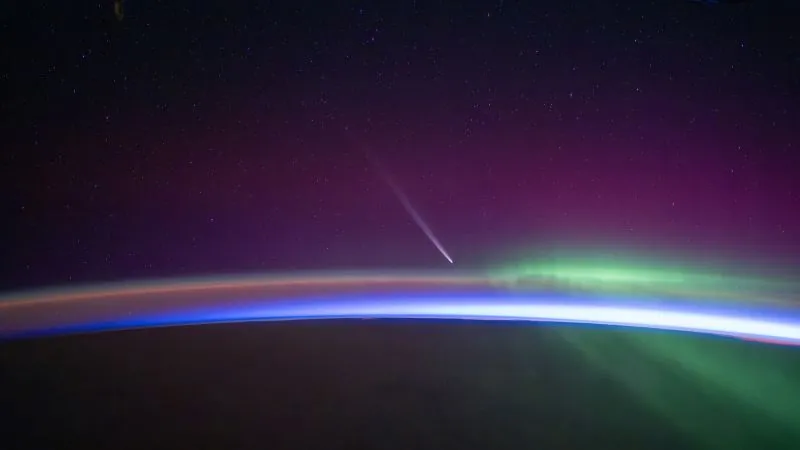
Don't Miss the Spectacular Approach of Comet C/2023 A3 Tsuchinshan–ATLAS This Weekend!
2024-10-09
Author: Ying
Exciting news for stargazers! The recently discovered comet, C/2023 A3 Tsuchinshan–ATLAS, is set to make its closest approach to Earth this Saturday, and it's an event you won't want to miss. This will likely be the comet's only appearance in our skies for the next 80,000 years, making it a celestial spectacle of a lifetime!
C/2023 A3 Tsuchinshan–ATLAS reached its closest point to the sun, called perihelion, on September 27. It was visible to observers in the Southern Hemisphere during late September to early October. Now, it's making headlines again as it becomes visible in the Northern Hemisphere from mid-October to early November, according to NASA.
During its flyby on Saturday, the comet will approach our planet at a distance of approximately 44 million miles (nearly 71 million kilometers). This is its first documented flyby of Earth, a remarkable journey that has taken it 80,000 years back in time to when Neanderthals roamed the planet.
For those eager to catch a glimpse of this stunning celestial object, the best time to view the comet is just after sunset in the western night sky. It will appear as a bright fireball trailing a long tail, a breathtaking sight that promises to dazzle.
NASA’s Bill Cooke, head of the Meteoroid Environment Office, recommends using binoculars for an enhanced viewing experience. He noted, "It’s not going to zing across the sky like a meteor. It will just appear to hang there, moving slowly from night to night. If you can see it with your unaided eye, binoculars will knock your socks off!"
The Journey of Tsuchinshan–ATLAS
Discovered in 2023, Tsuchinshan–ATLAS owes its name to two observatories: China's Tsuchinshan Observatory and the Asteroid Terrestrial-impact Last Alert System (ATLAS) telescope in South Africa. This icy body hails from the Oort Cloud, a region filled with ancient comets orbiting far from the sun.
Scientists were initially uncertain whether the comet would survive its passage near our sun, but it has held up exceptionally well and is reported to be largely intact. As it approaches the sun, the phenomenon of forward scattering will cause it to shine brightest around mid-week, although its visibility will be hampered by the glare of the sun until several days later.
If you can't see Tsuchinshan–ATLAS in person, don’t worry! The Virtual Telescope Project in Italy will host a live feed on Wednesday, showcasing the comet during its peak brightness and again on Saturday for its closest distance to Earth.
A Rare Opportunity
According to astronomer Dr. Teddy Kareta, witnessing a bright comet is a captivating experience, particularly for children and newcomers to astronomy. "Comets that are easily visible to many are rare, so if you have the chance to see it, take it! Bring your friends and family—this is a moment to share and treasure together."
What's Next?
Mark your calendars for the next celestial event happening soon! The full moon on October 17, known as the Hunter's Moon, will occur, but be aware that its brightness might obscure other celestial images in the night sky. The proximity of this supermoon is approximately 222,095 miles (357,428 kilometers) away from Earth, making it the closest full moon of the year.
Looking ahead, brace yourself for more cosmic wonders as another comet, C/2024 S1 (ATLAS), might grace our skies later in October. And meteor shower enthusiasts will have plenty to look forward to as several major showers are expected to light up the sky through the rest of the year.
Prepare for a thrilling experience as the universe unfolds its wonders! Don't miss out on these celestial events that could be memories of a lifetime!



 Brasil (PT)
Brasil (PT)
 Canada (EN)
Canada (EN)
 Chile (ES)
Chile (ES)
 España (ES)
España (ES)
 France (FR)
France (FR)
 Hong Kong (EN)
Hong Kong (EN)
 Italia (IT)
Italia (IT)
 日本 (JA)
日本 (JA)
 Magyarország (HU)
Magyarország (HU)
 Norge (NO)
Norge (NO)
 Polska (PL)
Polska (PL)
 Schweiz (DE)
Schweiz (DE)
 Singapore (EN)
Singapore (EN)
 Sverige (SV)
Sverige (SV)
 Suomi (FI)
Suomi (FI)
 Türkiye (TR)
Türkiye (TR)